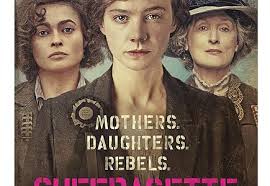The movie, ‘Suffragette’, does not ostensibly intend to establish parallels with other protest movements elsewhere but as the action unfolds, the early days of the Sixties Civil Rights movement in the Six Counties and, specifically in Derry where I had an active role, were vividly recalled. The action opens in an East London laundry where Maud (Carey Mulligan) has worked for a pittance from childhood. Shirt factories were the biggest employers in Derry and the labour force was 99% female. When the notoriously bigoted Home Affairs Minister, Bill Craig, in 1969, banned all marches within the City walls, except by his fellow Orangemen, the factory women downed tools and paraded around the town for two days.
The movie chooses a point in the suffragette journey when the activists realise that peaceful petitioning of Parliament is a waste of energy and only militant activism will have real impact. When sections of the right wing media describe a woman as ‘militant feminist’ , they give voice to those men who feel that women should know their place. Social awakening and patriarchal lawmaking have no place in their lexicon. In time, civil rights activists, in the eyes of some commentators, would become rebels, republicans and communists who sought to bring down the State.
The film uses a documentary style with hand held cameras for some of the scenes at Epsom and to great effect in depicting police brutality against protesters. The cynical Special Branch officer ( a bear-like Brendan Gleeson ) sees no merit in ‘Votes For Women’ and relishes watching his thuggish police violently attack a rally which had gathered to hear Emily Pankhurst ( a posh Meryl Streep) speak from a town house balcony and encourage increased action. My mind’s eye clearly recalls Chief Inspector Ross McGimpsy’s brutal attack on a cub reporter in Duke Street on the 5th October 1968.
In the movie , working class, courageous women were the foot soldiers for middle class leaders; they saw peaceful protest achieve nothing and the gradual change to more militant confrontation – blowing up post boxes , the burning of Lloyd George’s summer home and eventually the ultimate, blood sacrifice on Derby Day.
The director (Sarah Gavron) makes clear in the end that the suffragette movement may have obtained votes for women but their struggle against a well entrenched, male establishment continues.
Similar rigidity is a hallmark of some Northern Ireland Unionist thinking; much remains to be done.

I recall watching Bullit in thevWhitla Hall as part of Freshers Week QUB in 1968 when a guy jumped on stage and shouted;”A civil Rights march outside Bill Craig’s house now.”
My parents were mortified when I appeared on the evening news, journalists in those days identified with those that took on the establishment not like in Scotland today!
I like the way you linked some of the things the Suffragettes and Civil Rights movement in N. Ireland did have in common.
Thanks for your comment, Brian. Queens students were an important and crucial part of the action. My cousin, Malachy, was present on Oct 5th and escaped the police attack to take refuge in my aunt’s house in the Waterside. There he found a very disapproving headteacher father visiting.
It is a challenge for a movie to contain within 90 mins or so the complexity of the struggle at the time and it isn’t perfect but it is a brave attempt and there are some great acting performances. I don’t mention Helena Bonham-Carter in the blog but she is outstanding as a revolutionary pharmacist. You will know that the early civil rights groups adopted the American model, using ‘We Shall Overcome’ as a sitdown anthem.